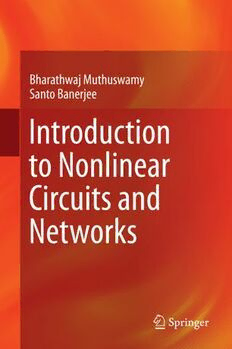Table Of ContentBharathwaj Muthuswamy
Santo Banerjee
Introduction
to Nonlinear
Circuits and
Networks
Introduction to Nonlinear Circuits and Networks
Bharathwaj Muthuswamy • Santo Banerjee
Introduction to Nonlinear
Circuits and Networks
123
BharathwajMuthuswamy SantoBanerjee
DepartmentofPhysics InstituteforMathematicalResearch
QuESTLab UniversityPutraMalaysia
StevensInstituteofTechnology Serdang,Malaysia
Hoboken,NJ,USA
ISBN978-3-319-67324-0 ISBN978-3-319-67325-7 (eBook)
https://doi.org/10.1007/978-3-319-67325-7
LibraryofCongressControlNumber:2018949725
©SpringerInternationalPublishingAG,partofSpringerNature2019
Thisworkissubjecttocopyright.AllrightsarereservedbythePublisher,whetherthewholeorpartof
thematerialisconcerned,specificallytherightsoftranslation,reprinting,reuseofillustrations,recitation,
broadcasting,reproductiononmicrofilmsorinanyotherphysicalway,andtransmissionorinformation
storageandretrieval,electronicadaptation,computersoftware,orbysimilarordissimilarmethodology
nowknownorhereafterdeveloped.
Theuseofgeneraldescriptivenames,registerednames,trademarks,servicemarks,etc.inthispublication
doesnotimply,evenintheabsenceofaspecificstatement,thatsuchnamesareexemptfromtherelevant
protectivelawsandregulationsandthereforefreeforgeneraluse.
Thepublisher,theauthorsandtheeditorsaresafetoassumethattheadviceandinformationinthisbook
arebelievedtobetrueandaccurateatthedateofpublication.Neitherthepublishernortheauthorsor
theeditorsgiveawarranty,expressorimplied,withrespecttothematerialcontainedhereinorforany
errorsoromissionsthatmayhavebeenmade.Thepublisherremainsneutralwithregardtojurisdictional
claimsinpublishedmapsandinstitutionalaffiliations.
ThisSpringerimprintispublishedbytheregisteredcompanySpringerNatureSwitzerlandAG
Theregisteredcompanyaddressis:Gewerbestrasse11,6330Cham,Switzerland
DedicatedtoLeon O.Chua, RobertM. Fano,
Lan J.Chu, andRichardB. Adler
Preface
The purposeof this course-basedtext-bookis to emphasize introductoryconcepts
fromclassicideasinnonlinearcircuittheory:
1. Thebookiscompletelyself-containedanddoesnotassumeanypriorknowledge
of circuit theory. It is simply assumed that the reader has taken a first-year
undergraduate (elementary) course in differential and integral calculus, along
with elementary physics courses in classical mechanics and electrodynamics
(with an exposureto matrix algebra). Hence, this bookshould be accessible to
anymotivatedindividualwhohastakentheabovementionedcourses.
2. The book also covers topics that are not typically found in standard circuit
textbooks,suchas:
(cid:129) Memristors. Thejustificationis thatalthough(asthe readerwilllearnfrom
thisbook)memristorsarenotusedinlinearcircuittheory,amemristoristhe
fourthfundamentalcircuitelement.Hence,itisonlylogicalthatanytexton
circuit theory discuss memristors. Thus, ideally our book would have been
titled Introductionto Circuits and Networks. But then a casualreader might
mistakethisbookforemphasizingonlylinearcircuittheory.However,asthis
bookwillshow,nonlinearcircuittheory(memristorincluded)isaccessibleto
anyonewiththecorrectbackgroundwhoisinterestedinfundamentalcircuit
theoreticconcepts.
(cid:129) Nonlinear chaotic circuits. We believe that chaotic circuits elegantly inte-
grate a variety of concepts from circuit theory and hence form a natural
repositoryof“projects”forthereadertounderstandalltheconceptsdiscussed
inthisbook.
(cid:129) Nonlinear operational amplifier circuits, for example, Schmitt triggers.
As will be clear from this book, accurate analysis of Schmitt triggers will
helpdispelcommonmisconceptsaboutthenatureofhysteresisinelectronic
circuitsandwillalsohelpthereaderunderstandthedeepconceptofmodeling.
3. Eachchapterhasillustrativeexamples,exercises,andalabcomponent.Wewill
also have (maximum 20 min) conceptual videos for each chapter and end-of-
chapter exercises (lab included) online. The purpose of these supplementary
vii
viii Preface
videosis to (a)highlightmajorconceptsin each chapterand(b) providesolu-
tions(hintsforopen-endedproblems)toend-of-chapterexercises.Thisextensive
useofelectronicaidsisthe“twenty-firstcentury”approachtononlinearcircuits.
In the process, we hope to “transform” fundamentalideas in nonlinearcircuits
fromtheclassicworksofLeonO.Chuaandothers.Nevertheless,thegoalofthis
book’selectronicaidsistosupplement,notreplace,rigor.
Over the course of a teaching career spanning 10 years at the University of
California(UC)Berkeley,Dr.MuthuswamyhascoordinatedwithDr.LeonO.Chua
and others to reintroduce nonlinear circuit theory at an elementary level. Much
of the material in this book is thus derived from Dr. Chua’s EE100 (Electronic
Techniques for Engineering) lecture materials. This course was offered by the
ElectricalEngineeringandComputerSciencesdepartmentatUCBerkeleyfornon-
electricalengineeringmajors.Thus,the approachtakenbyEE100(andthisbook)
is a top-down view of circuit analysis where we discuss general principles and
emphasize device modeling. Therefore,the material in this book can be adopted
foranintroductorycourseincircuittheory.
AttheUniversityofCalifornia,Berkeley,wewereabletocovermost(excluding
memristors) of the material in this book in one semester. The material on chaotic
circuitswasusedasasourceofprojects.Forschoolsthatarebasedontheshorter
quarter system (10 weeks of instruction), we would suggest splitting the material
inthisbookintotwocourses.ThefirstcoursecouldcoverChaps.1and2(network
elements).ThesecondcoursewouldcoverChaps.3–5,whereChaps.3and4discuss
techniquesofnetworkanalysisfollowedbyChap.5asasourceofcourseprojects.
Anotheroptionwouldbetocoverresistivenetworksinthefirstcourseanddynamic
networksinthesecondcourse.Specifically:
1. First course—resistivenetworks:onlyexcludingmaterialondynamicelements
inChaps.1and2(Sects.1.9.3–1.9.5,2.2.3,2.2.4)andcoveringallofChap.3.
2. Second course—dynamicnetworks:coverdynamicelements in Chaps.1 and 2
thatwerenotcoveredinthefirstcourse,followedbyChaps.4and5.
Hence,thewaywehaveorganizedthechaptersisbasedonthefactthat,incircuit
theory,thelawsofelementsaredistinctfromthelawsofnetworks.
Our goal in writing this book is simple: a studentwho thoroughlyunderstands
theconceptsin thisbookwillbewellpreparedforanyfollow-upcourseincircuit
theory.Forreaderswhoarefurtherinterestedinadvancedconcepts,weareplanning
towriteafollow-upvolume,AdvancedNonlinearCircuitsandNetworks.Areader
whothoroughlyunderstandsthematerialinbothvolumeswillmaximizeknowledge
gainedfromanyfollow-upelectricalengineeringcourse,sinceourbooksoncircuit
theoryemphasizeboththeunderlyingmathematicsandphysicalexperiments.
Hoboken,NJ,USA BharathwajMuthuswamy
Serdang,Malaysia SantoBanerjee
Acknowledgements
There are a plethora of folks whom we have to thank. From Dr. Muthuswamy’s
perspective, first and foremost, he would like to thank his MS and PhD advisor
Dr. Leon O. Chua for all his support and guidance. Particularly for this book,
Dr. Chua guided us in organizing the content. His advice to extract simple yet
novelconceptson nonlinearcircuit theoryfrom his classic works, Introductionto
NonlinearCircuitTheoryandLinearandNonlinearCircuits,pavedthewayforthis
book. Dr. Muthuswamy was also deeply influenced by conversations with Dr. H.
GopalakrishnaGadiyar and Dr. Ganesan from the Vellore Institute of Technology
in the summer of 2014. Their suggestion was to “capture the nonlinear circuits
knowledge” of Dr. Leon O. Chua. Thus, capturing that knowledge is the primary
purposeofthisbook.
FerencKovac,CarlChun,andDr.PravinVaraiyafromBerkeleyhavebeenboth
professionaland personalmentorsthroughoutthe years. From Dr. Muthuswamy’s
academic career in Wisconsin, interactions with Dr. Jovan Jevtic and Dr. Gerald
Thomas have been motivational and inspiring. Dr. Sunil T. Mathew from the
University of Oklahoma has provided invaluable advice regarding the role of
biological memristors. Dr. Muthuswamy would also like to thank his former
colleaguesatTaranaWirelessfortheirsupportwhenwritingadraftversionofthis
bookforapproval.TheCollegeofNewJersey(Dr.Muthuswamy’semployerwhile
writingthemajorityofthebook)alsodeservesspecialthanks.
Wewouldalsoliketothanktheanonymousreviewersforhelpingusreformulate
the content of this book, so as to make it sustainable. Without Springer’s support
throughoutthewritingprocess,thisbookwouldnothavebeenpossible.DanFunke
from the College of New Jersey also read through the manuscript and provided
valuablefeedback.
Dr. Muthuswamy would also like to thank his family for their moral
support throughout the process: daughters Shambavi and Thejasvi, father M.G.
Muthuswamy, mother Chandra Muthuswamy, brother Karthikeyan Muthuswamy,
and sister-in-law Mamta. Last but not the least, Dr. Muthuswamy would like to
thank his spiritual advisor, Rajan Kurunthappan and family, for their continued
unconditionalsupportoverthelasttwodecades.
ix
Mathematical Notation
The mathematical notation used in this book is standard [15]; nevertheless, this
sectionclarifiesthenotationusedthroughoutthebook.
1. LowercaselettersfromtheLatinalphabet(a−z)areusedtorepresentvariables,
with italic script for scalars and bold invariably reserved for vectors. The
letter t is of course always reserved fo√r time. n is usually reserved for the
dimension of the state. j is used for −1, in accordance with the usual
electricalengineeringconvention.Mathematicalconstantssuchasπ,e,andh
(Planck’sconstant)havetheirusualmeaning.Otherconstantscalarsareusually
drawnfromlowercaseGreekalphabet.SIunitsareused.
2. Independent variable in functions and differential equations is time (unless
otherwisestated)becausephysicalprocesseschangewithtime.
dy
3. Differentiation is expressed as follows. Time derivatives use Leibniz’s ( ,
dx
for example) or Newton’s notation: one, two, or three dots over a variable
correspond to the number of derivatives and a parenthetical superscripted
numeral for higher derivatives. Leibniz’s notation is used explicitly for non-
timederivatives.∂ istheusualsymbolforindicatingpartialderivatives.
4. Real-valued functions,whether scalar- or vector-valued,are usually taken (as
conventionally)fromlowercaseLatinlettersf throughh,r,ands,alongwith
x throughz.
5. Vector-valuedfunctionsandvectorfieldsareboldfacedaswell,thedifference
between the two being indicated by the argument font, hence f(x) and f(x),
respectively.
6. Constant matrices and vectors are represented with capital and lowercase
letters,respectively,fromthebeginningoftheLatinalphabet.Vectorsareagain
bolded.
7. In the context of linear time-invariant systems, the usual conventions are
respected:Aisthestatematrix;B(b)istheinputmatrix(vector).
8. Subscripts denote elements of a matrix or vector: d is the ith column of D;
i
x is the jth element of x. Plain numerical superscripts on the other hand
j
may indicate exponentiation, a recursive operation, or simply a numbering
xi
xii MathematicalNotation
depending on the context. A superscripted T indicates matrix transpose. I is
reserved for the identity matrix. All vectors are assumed to be columns. det
standsfordeterminantofasquarematrix.
9. Σ isusedforsummations,samplingintervalissymbolizedbyT,and∈denotes
i
setinclusions.
10. Calligraphic script (R, etc.) is reserved for sets which use capital letters.
Elementsofsetsarethenrepresentedwiththecorrespondinglowercaseletter.
Exceptedarethewell-knownnumbersetswhicharerenderedindoublestruck
bold:N,Z,Q,R,andCforthenaturals,integers,rationals,reals,andcomplex
numbers,respectively.Thenaturalnumbersaretakentoinclude0.Restrictions
to positive or negative subsets are indicated by a superscripted + or −. The
(cid:4)
symbol= is used fordefinitions.∀and ∃havethe usualmeaningof “forall”
and“thereexists,”respectively.

